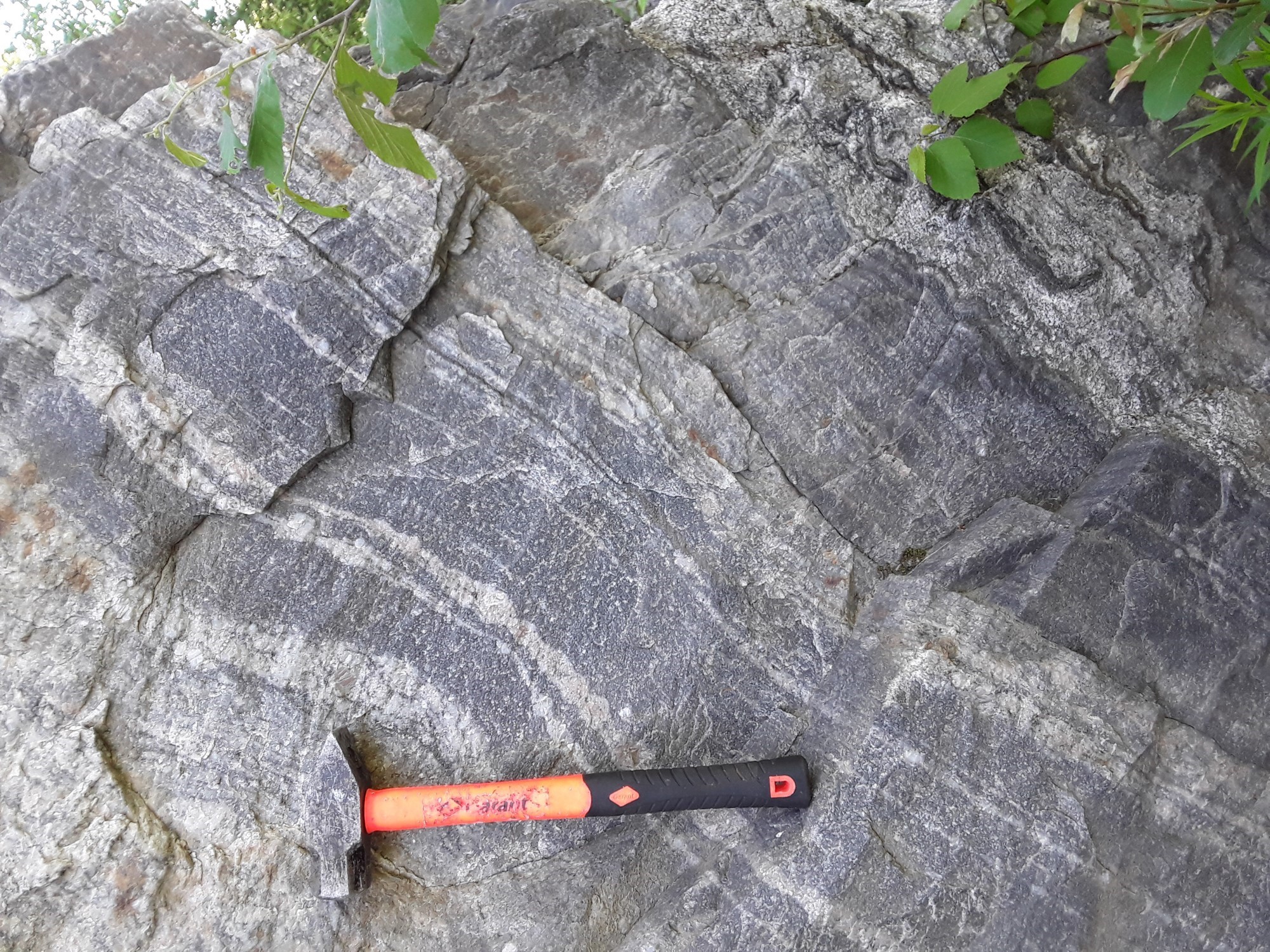
DISCLAIMER: This English version is translated from the original French. In case of any discrepancy, the French version shall prevail.
| Author(s): | Bilodeau, 2022 |
| Age: | Mesoproterozoic |
| Stratotype: | Reference outcrops 2021-CB-1007, 2021-CB-1121 and 2021-CB-1127 |
| Type area: | Île-du-Grand-Calumet (NTS sheet 31F10) |
| Geological province: | Grenville Province |
| Geological subdivision: | Allochton |
| Lithology: | Felsic intrusive rocks |
| Category: | Lithodemic |
| Rank: | Suite |
| Status: | Formal |
| Use: | Active |
None
Background
The Litchfield Intrusive Suite (mPlit) was introduced by Bilodeau (2022) after a geological survey carried out in the Île-du-Grand-Calumet area in 2021. Some outcrops of this unit were described by Osborne (1944), Katz (1976) and Madore et al. (1994) east of the Campbell’s Bay municipality.
Description
The Litchfield Intrusive Suite (mPlit) is a polyphase felsic batholith. It is made up of two different subunits defined on the basis of their respective lithological assemblages, structures and geochemical signatures. The mPlit1 subunit consists of a banded tonalitic gneiss highly intruded by felsic material, and an associated granodiorite intrusion (mPlit1a). The mPlit2 subunit corresponds to a later tonalite intrusion.
Litchfield Intrusive Suite 1 (mPlit1): Slightly migmatized tonalitic to granodioritic gneiss
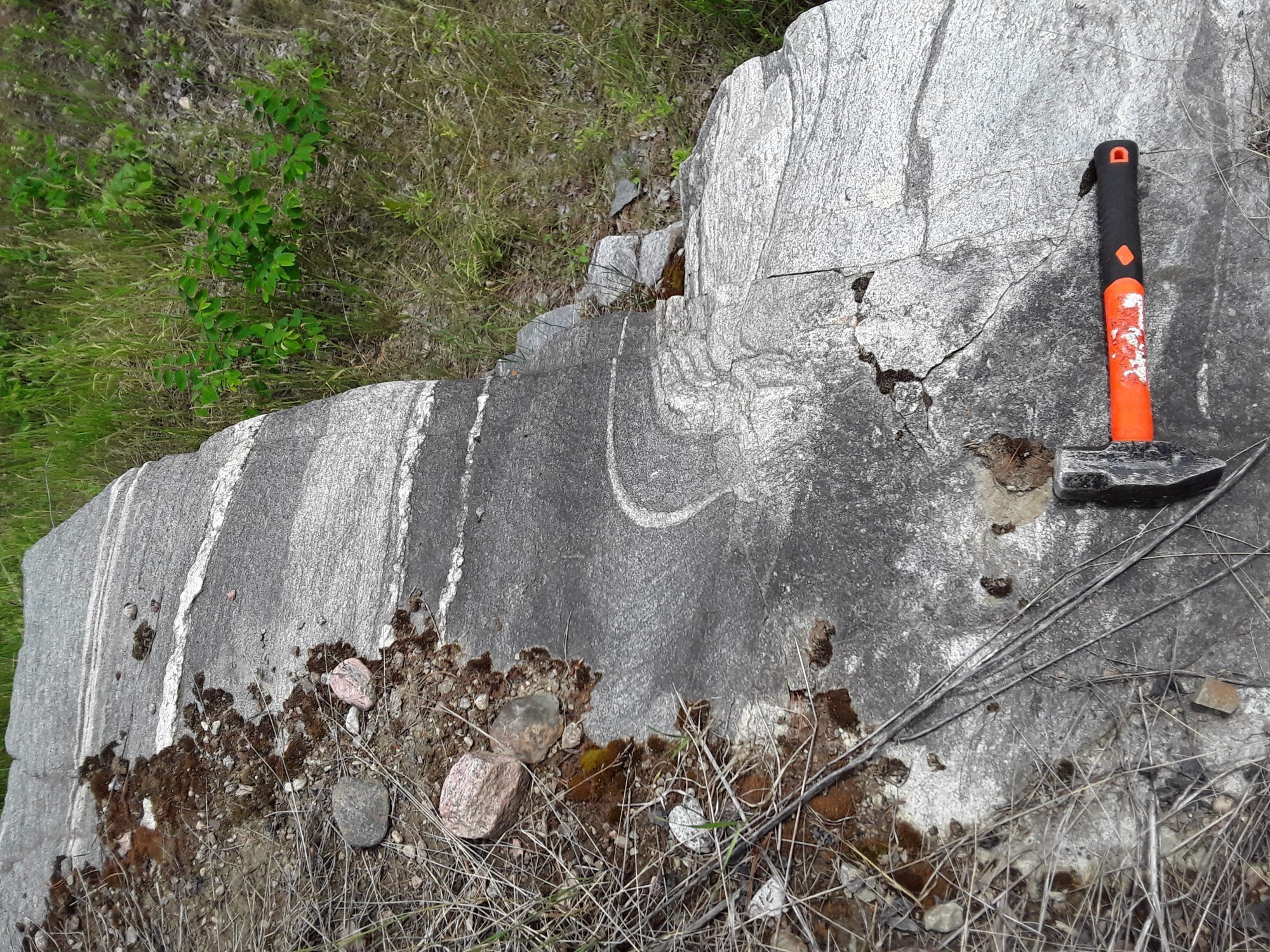
 This gneiss unit is banded and highly intruded by interfoliar sills of tonalitic to granitic composition. Overall, the rock has a grey to dark grey alteration patina. Some outcrops display alternating light and dark grey bands, 10 cm to 20 cm thick, and in sharp contact with each other. In fresh surface, light bands are grey, while dark bands are dark grey. The rocks are composed of heterogranular and granoblastic quartz and plagioclase of fine to medium grain size. K-feldspar is generally very sparse, or even absent in some samples. Secondary minerals include ~10% homogeneously distributed fine hornblende, up to 5% fine biotite and magnetite (in some dark bands), and <1% fine garnet in some outcrops. Accessory minerals include zircon, apatite and titanite.
This gneiss unit is banded and highly intruded by interfoliar sills of tonalitic to granitic composition. Overall, the rock has a grey to dark grey alteration patina. Some outcrops display alternating light and dark grey bands, 10 cm to 20 cm thick, and in sharp contact with each other. In fresh surface, light bands are grey, while dark bands are dark grey. The rocks are composed of heterogranular and granoblastic quartz and plagioclase of fine to medium grain size. K-feldspar is generally very sparse, or even absent in some samples. Secondary minerals include ~10% homogeneously distributed fine hornblende, up to 5% fine biotite and magnetite (in some dark bands), and <1% fine garnet in some outcrops. Accessory minerals include zircon, apatite and titanite.
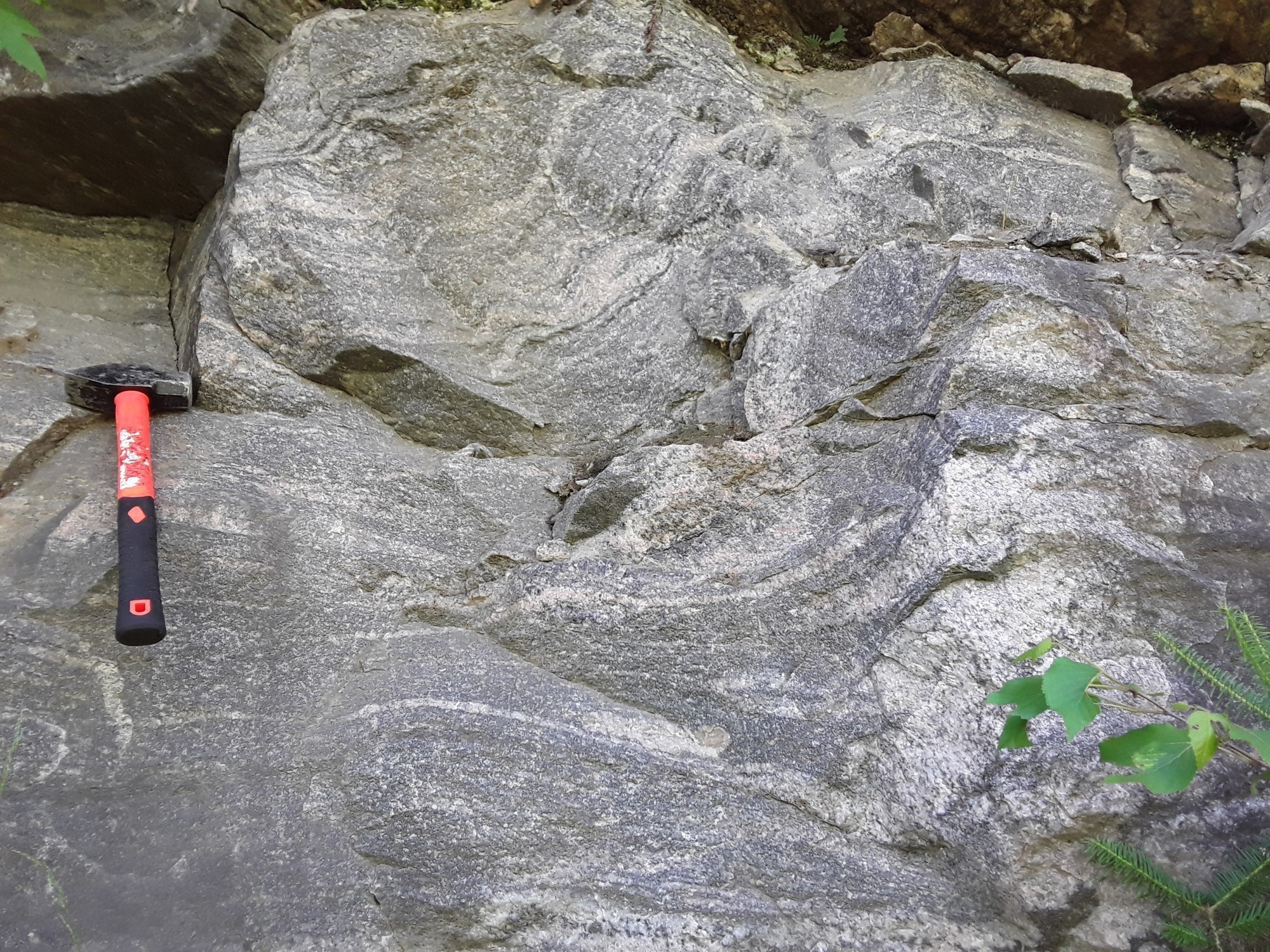
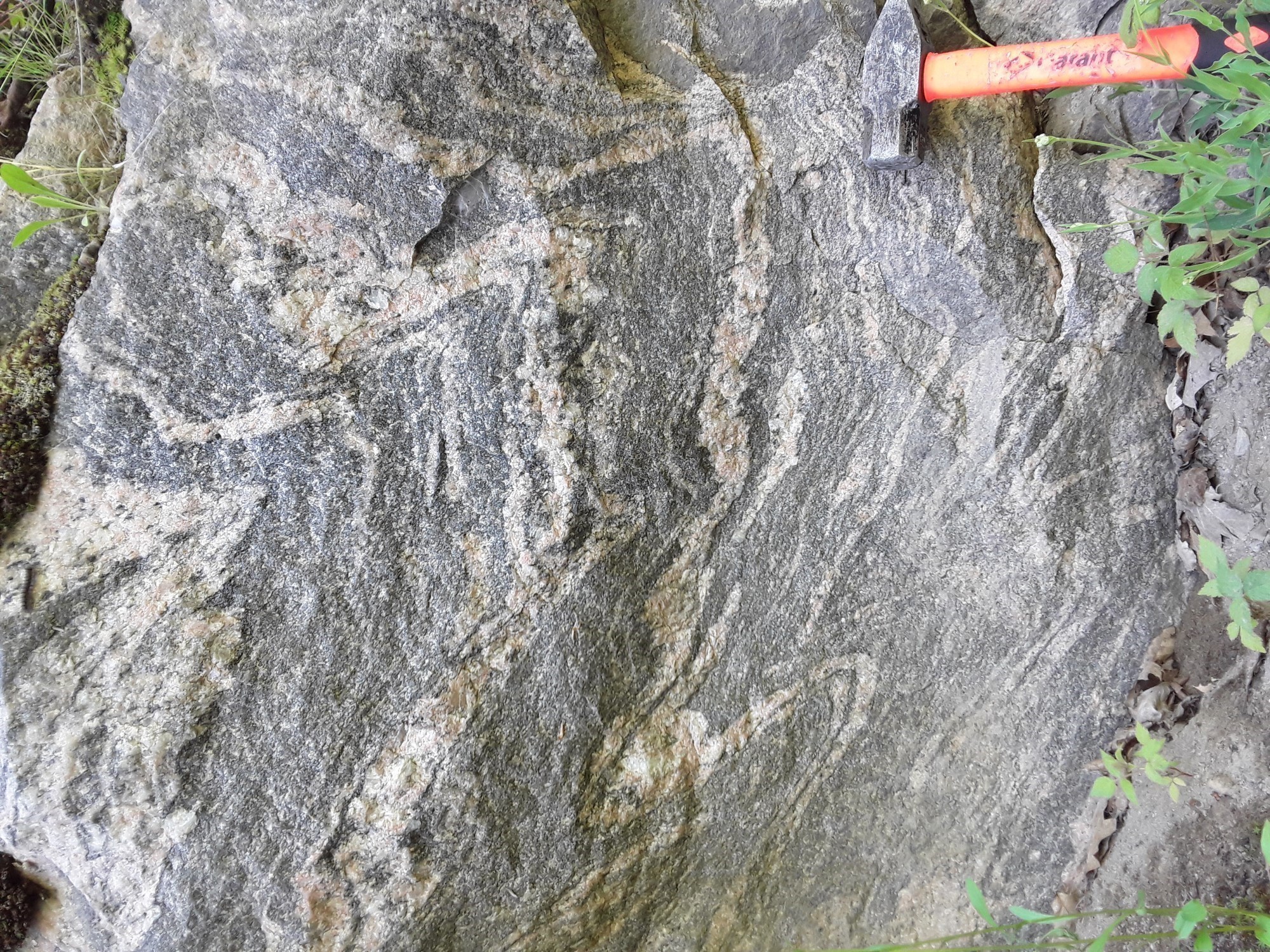
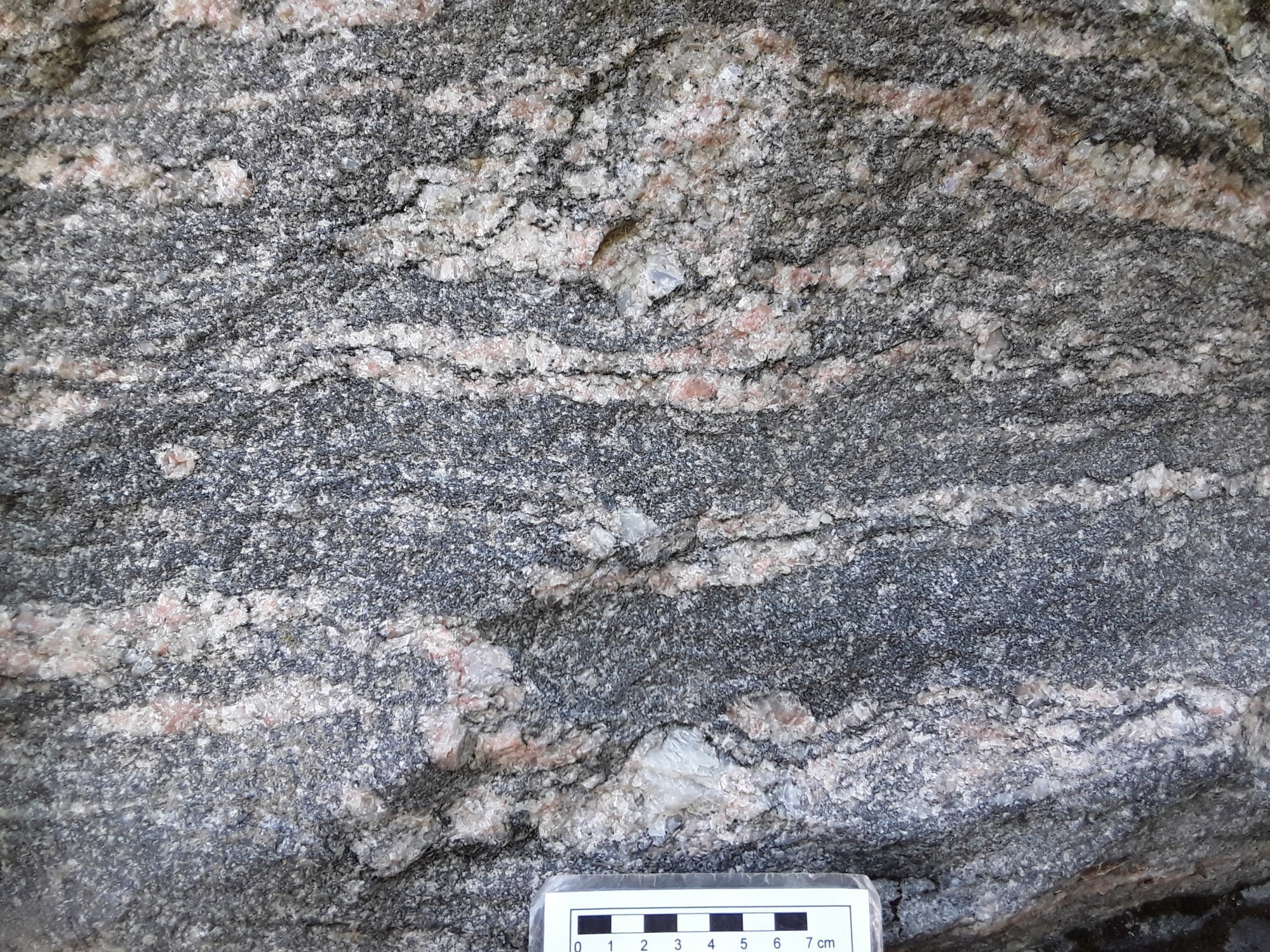 The rocks are commonly marked by a very pronounced foliation, defined in particular by the preferential orientation of hornblende. In some outcrops, this fabric is affected by folding of decimetric amplitude. Gneissosity is defined by the segregation of ferromagnesian minerals which define the colour of the bands, but above all by the common presence of small injections concordant with the tonalitic to granitic foliation. These injections have a hololeucocratic patina, generally white or with a light-pink tinge in places. Their thickness is highly variable, but generally ranges from 1 cm to 5 cm. Larger boudins or clusters are located in the fold hinges and have a maximum thickness of 3 dm. Injections are composed of highly variable amounts of quartz, plagioclase and K-feldspar, the latter locally forming phenocrysts 1 cm to 2 cm in size (Osborne, 1944). The high proportion of injections in certain outcrops suggests a relatively proximal source of magma. Evidence of partial melting in the gneiss is commonly obliterated by the recrystallization of quartz and feldspar. The migmatization hypothesis is supported by the omnipresence of mobilisate injections at the band interface in the majority of outcrops.
The rocks are commonly marked by a very pronounced foliation, defined in particular by the preferential orientation of hornblende. In some outcrops, this fabric is affected by folding of decimetric amplitude. Gneissosity is defined by the segregation of ferromagnesian minerals which define the colour of the bands, but above all by the common presence of small injections concordant with the tonalitic to granitic foliation. These injections have a hololeucocratic patina, generally white or with a light-pink tinge in places. Their thickness is highly variable, but generally ranges from 1 cm to 5 cm. Larger boudins or clusters are located in the fold hinges and have a maximum thickness of 3 dm. Injections are composed of highly variable amounts of quartz, plagioclase and K-feldspar, the latter locally forming phenocrysts 1 cm to 2 cm in size (Osborne, 1944). The high proportion of injections in certain outcrops suggests a relatively proximal source of magma. Evidence of partial melting in the gneiss is commonly obliterated by the recrystallization of quartz and feldspar. The migmatization hypothesis is supported by the omnipresence of mobilisate injections at the band interface in the majority of outcrops.
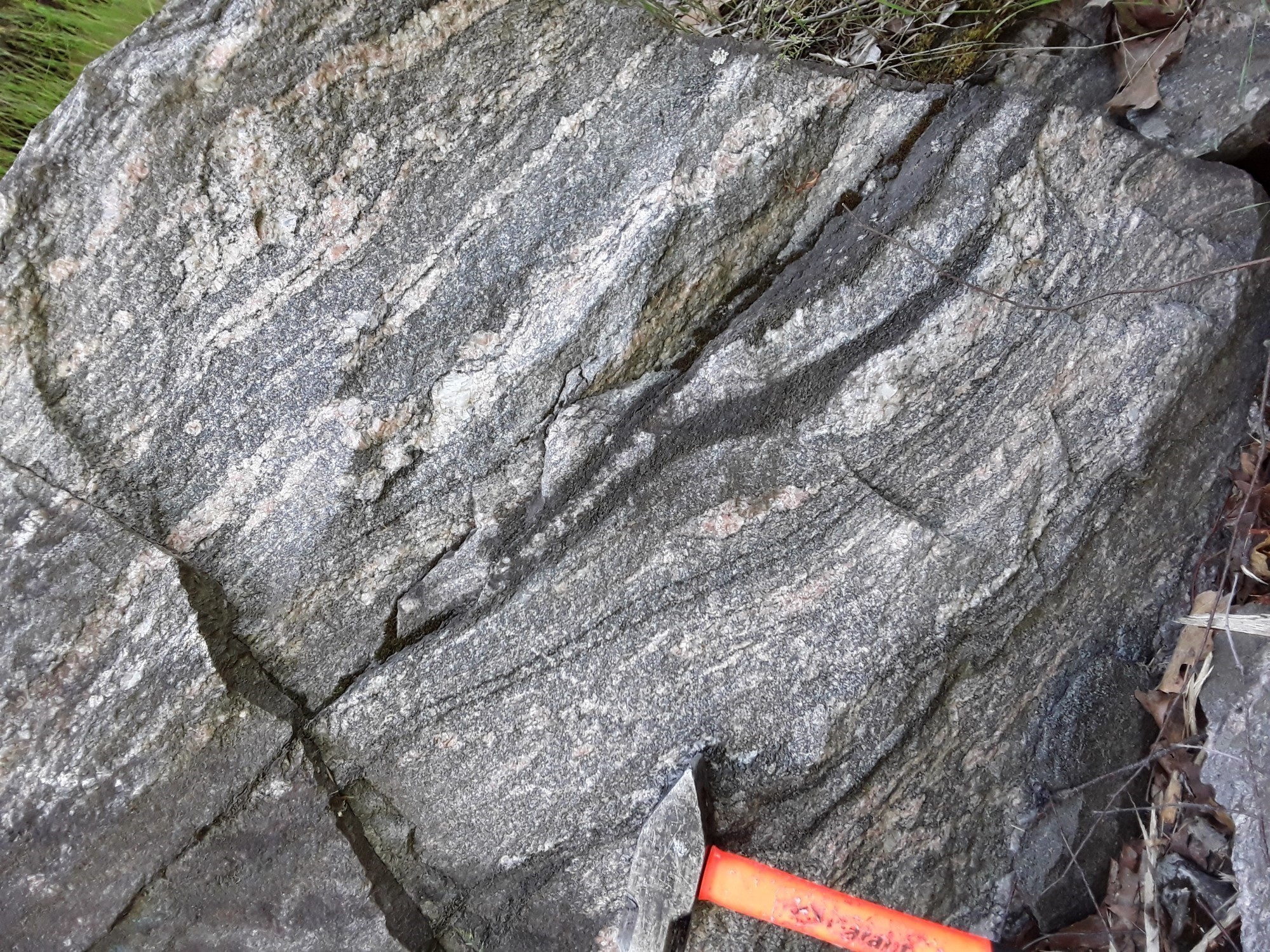 Some outcrops contain up to 5% mafic melanocratic layers, 2 cm to 5 cm thick, consisting mainly of recrystallized equigranular hornblende. Some layers locally form continuous metric layers of metagabbro concordant with the foliation.
Some outcrops contain up to 5% mafic melanocratic layers, 2 cm to 5 cm thick, consisting mainly of recrystallized equigranular hornblende. Some layers locally form continuous metric layers of metagabbro concordant with the foliation.
Litchfield Intrusive Suite 1a (mPlit1a): Heterogranular granodiorite
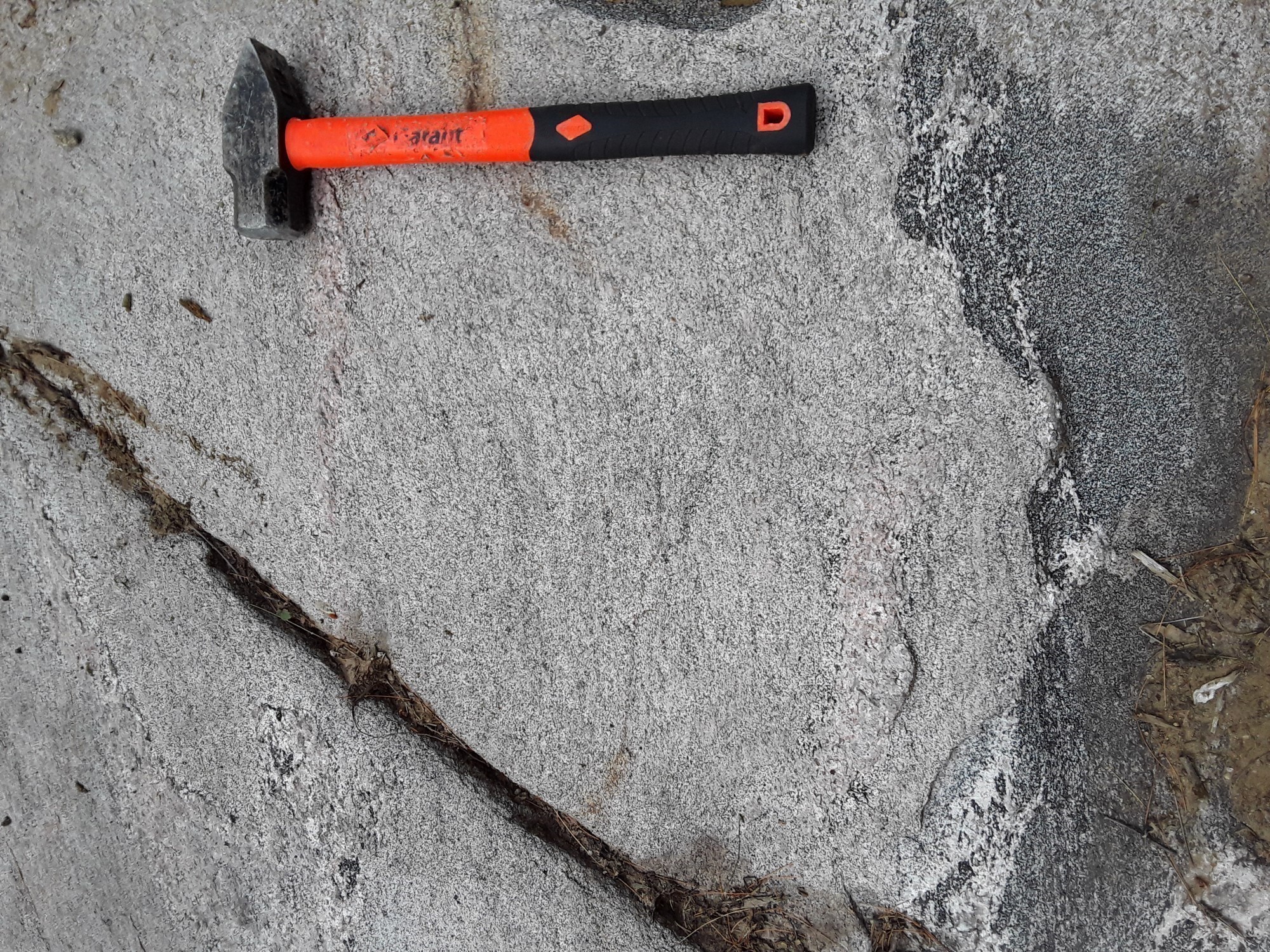
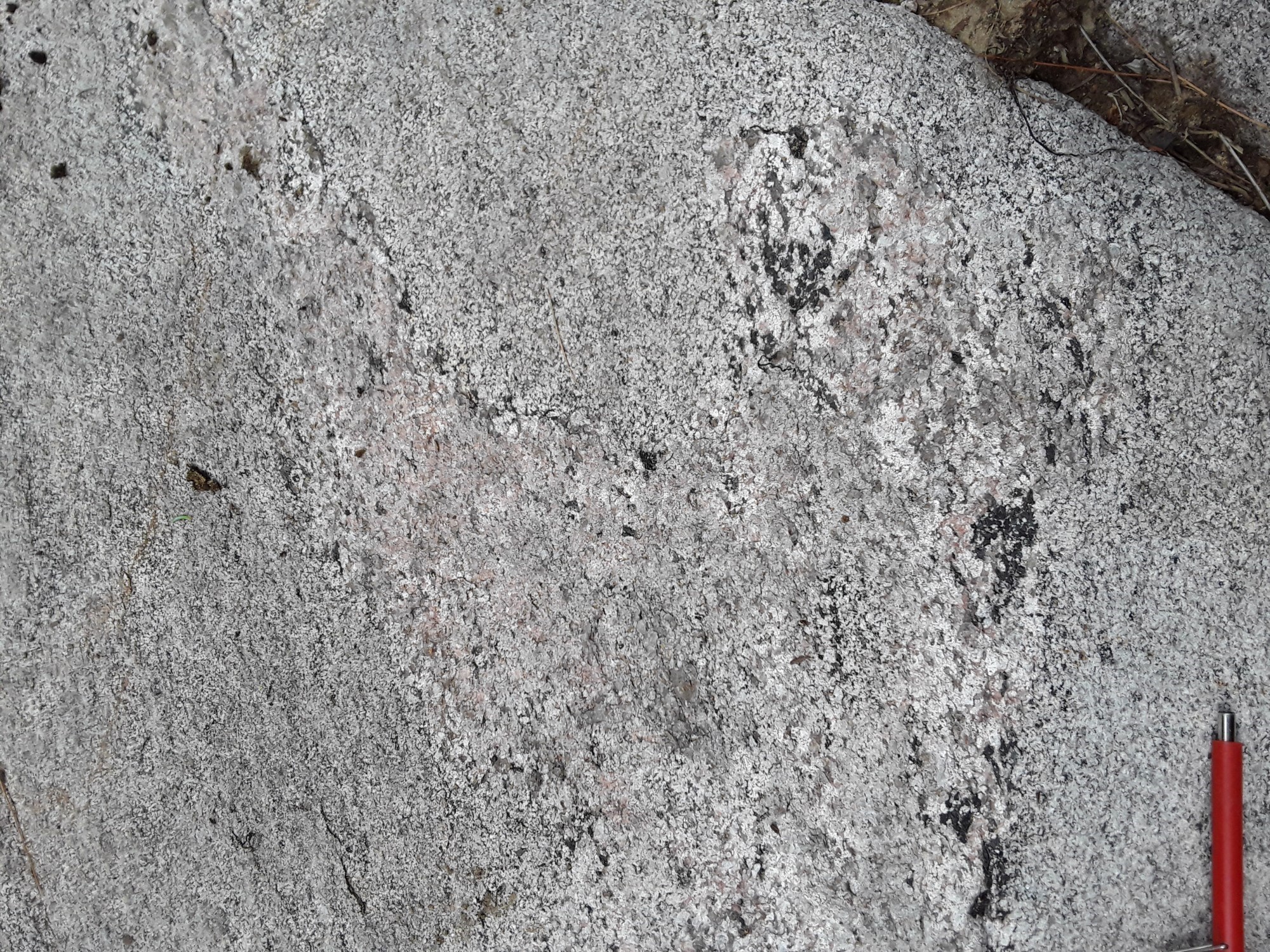
 This subunit corresponds to a granodiorite intrusion with a geochemical signature similar to that of the adjacent gneiss (mPlit1). Rocks have a light beige or light grey-beige weathered surface and a grey to dark grey fresh surface, locally with beige or pink tints. They are generally fine grained, locally fine to medium grained, fairly homogeneous in composition and foliated. In places, the grain size is very heterogeneous. The rock is marked by the sporadic presence of diffuse medium- to coarse-grained clusters similar in composition to the host granodiorite. In addition to plagioclase, the rock contains ~30% quartz and a maximum of 20% K-feldspar. All these minerals have been recrystallized. Fine biotite occupies up to 15% of the volume of the rock, along with up to 5% hornblende. Magnetite is a characteristic mineral of this facies, as evidenced by the strong magnetic susceptibility anomaly in the low-resolution aeromagnetic survey. Other trace minerals include garnet, epidote and allanite. Secondary minerals form local concentrations in coarser clusters. Coarser phases also form planar injections with sharp contacts and concordant to foliation. They are typically hololeucocratic and very magnetic. A second family of pinkish interfoliar inirusons a few millimetres thick and non-magnetic is observed. Finally, granodiorite contains a small porportion of partially assimilated enclaves of granoblastic amphibolite up to 1 m long and 25 cm wide.
This subunit corresponds to a granodiorite intrusion with a geochemical signature similar to that of the adjacent gneiss (mPlit1). Rocks have a light beige or light grey-beige weathered surface and a grey to dark grey fresh surface, locally with beige or pink tints. They are generally fine grained, locally fine to medium grained, fairly homogeneous in composition and foliated. In places, the grain size is very heterogeneous. The rock is marked by the sporadic presence of diffuse medium- to coarse-grained clusters similar in composition to the host granodiorite. In addition to plagioclase, the rock contains ~30% quartz and a maximum of 20% K-feldspar. All these minerals have been recrystallized. Fine biotite occupies up to 15% of the volume of the rock, along with up to 5% hornblende. Magnetite is a characteristic mineral of this facies, as evidenced by the strong magnetic susceptibility anomaly in the low-resolution aeromagnetic survey. Other trace minerals include garnet, epidote and allanite. Secondary minerals form local concentrations in coarser clusters. Coarser phases also form planar injections with sharp contacts and concordant to foliation. They are typically hololeucocratic and very magnetic. A second family of pinkish interfoliar inirusons a few millimetres thick and non-magnetic is observed. Finally, granodiorite contains a small porportion of partially assimilated enclaves of granoblastic amphibolite up to 1 m long and 25 cm wide.
Litchfield Intrusive Suite 2 (mPlit2): Fine-grained homogeneous leucogranite

 This subunit corresponds to a distinct intrusion of fine-grained recrystallized leucocratic granite. The rock is hololeucocratic, very light grey to light grey-beige in altered patina and light grey to light grey-pink in fresh surface. The granite contains up to 40% quartz, a variable proportion of slightly damouritized (sericitized) plagioclase and very little K-feldspar. The unit contains few ferromagnesian minerals, including ~2% very fine biotite homogeneously distributed. A sample observed under the microscope displayss <1% euhedral pyrite and tourmaline. Other accessory minerals include zircon, apatite and titanite. Under the microscope, deformation of the minerals is marked by the undulatory extinction of quartz and feldspar, as well as very complex crystalline faces. The foliation is not well developed, as shown by the low preferential orientation of the minerals.
This subunit corresponds to a distinct intrusion of fine-grained recrystallized leucocratic granite. The rock is hololeucocratic, very light grey to light grey-beige in altered patina and light grey to light grey-pink in fresh surface. The granite contains up to 40% quartz, a variable proportion of slightly damouritized (sericitized) plagioclase and very little K-feldspar. The unit contains few ferromagnesian minerals, including ~2% very fine biotite homogeneously distributed. A sample observed under the microscope displayss <1% euhedral pyrite and tourmaline. Other accessory minerals include zircon, apatite and titanite. Under the microscope, deformation of the minerals is marked by the undulatory extinction of quartz and feldspar, as well as very complex crystalline faces. The foliation is not well developed, as shown by the low preferential orientation of the minerals.
Thickness and Distribution
The Litchfield Intrusive Suite is interpreted as a batholith of felsic composition (Madore et al., 1994) occupying a minimum area of 15 km by 15 km (NE corner of sheet 31F10). Tonalitic gneiss of the mPlit1 subunit probably corresponds to the >80 km-long band of migmatitized tonalitic gneiss that runs along the SE edge of the Lac Dumoine Lithotectonic Domain up to the north of the Cayamant municipality. The NW extension of the mPlit1a and mPlit2 subunits is not known in the adjacent sheet (sheet 31F15) and appears to be covered by Ordovician sedimentary rocks.
Dating
A sample of homogeneous and foliated gneiss from the mPlit1 subunit (outcrop 2021-CB-1124) was analyzed for LA-ICP-MS dating. Zircons yielded a U-Pb age of 1222 ±10 Ma, interpreted as the age of crystallization (Davis, 2023). No metamorphic age was obtained from this sample.
| Unit | Sample Number | Isotopic System | Mineral | Crystallization Age (Ma) | (+) | (-) | Reference(s) |
| mPlit1 | 2021-CB-1124A | U-Pb | Zircon | 1222 | 10 | 10 | Davis, 2023 |
Stratigraphic Relationship(s)
Geochronological data show that unit mPlit1 (1222 ±10 Ma) is the youngest unit in the NE part of the Île-du-Grand-Calumet area. It cuts through surrounding units, namely the Schwartz Intrusive Suite (1254 ±20 Ma), the Tancredia Intrusive Suite (1240 ±6 Ma), the Chenaux Intrusive Suite (1231 ±2 Ma, Easton, 1992; Pehrsson et al., 1996) and the Grand-Calumet Complex (1232.8 +3.9/-2.7 Ma, Gauthier, 2015). The relative chronology of the different Litchfield subunits could not be validated in the field.
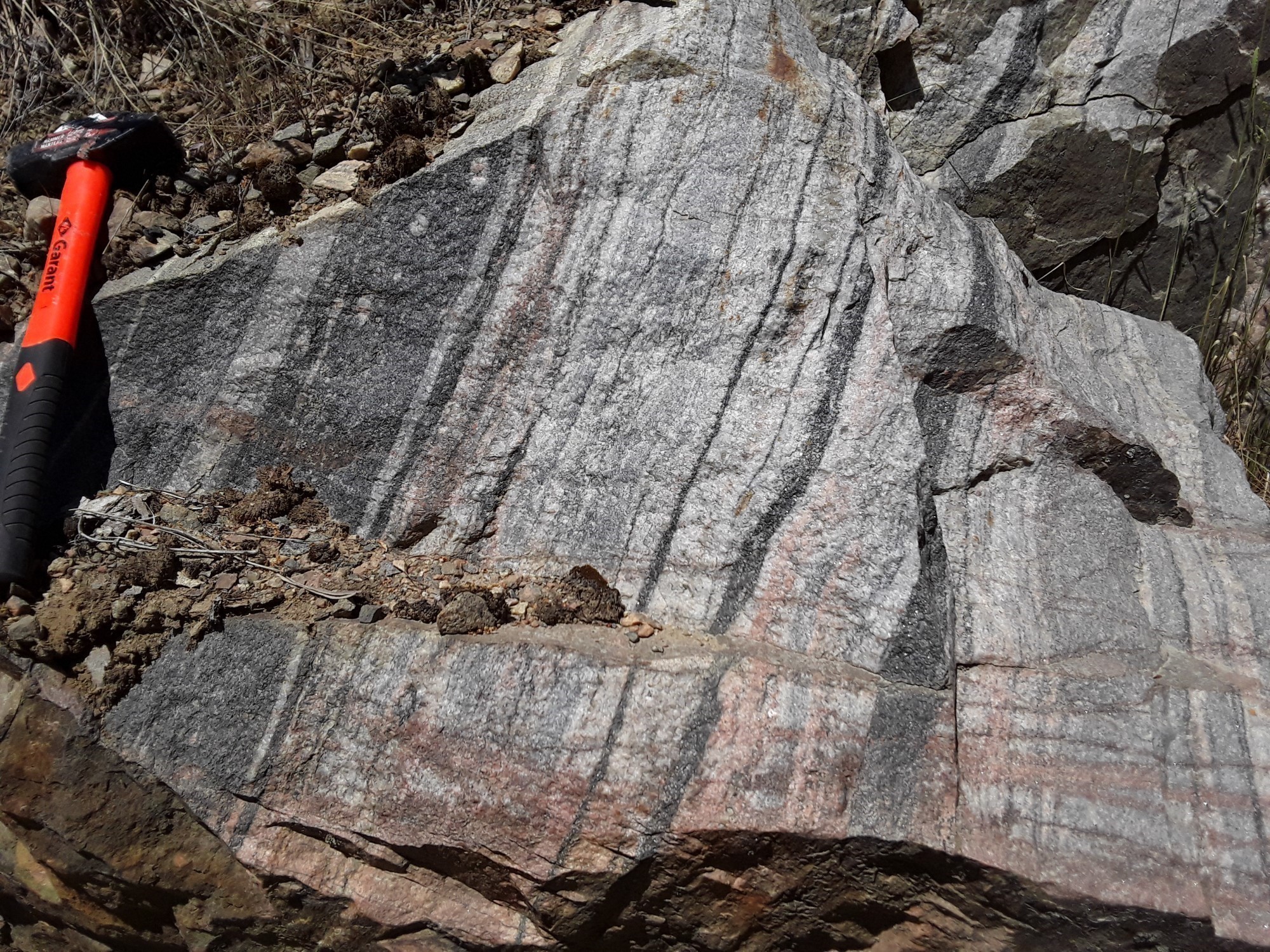 The western contact of the Litchfield can be seen in outcrop 2021-CB-1007. Bands of granite from the mPlit2 subunit alternate with bands of amphibolitized mafic rocks probably belonging to the surrounding Grand-Calumet Complex unit (mPgrc1). Similar observations were reported by Madore et al. (1994) in this area, interpreting the contact as the emplacement of lit-par-lit injections penetrating the grinding planes of the hornblende-biotite amphibolite (mPgrc1). This fault probably represents the Campbell’s Bay Deformation Zone (CBZ) delineating the two units.
The western contact of the Litchfield can be seen in outcrop 2021-CB-1007. Bands of granite from the mPlit2 subunit alternate with bands of amphibolitized mafic rocks probably belonging to the surrounding Grand-Calumet Complex unit (mPgrc1). Similar observations were reported by Madore et al. (1994) in this area, interpreting the contact as the emplacement of lit-par-lit injections penetrating the grinding planes of the hornblende-biotite amphibolite (mPgrc1). This fault probably represents the Campbell’s Bay Deformation Zone (CBZ) delineating the two units.
Paleontology
Does not apply.
References
Publications available through SIGÉOM Examine
BILODEAU, C. 2022. Géologie de la région de l’Île-du-Grand-Calumet, Province de Grenville, Outaouais, Québec, Canada. MERN; BG 2022-07, 1 plan.
DAVIS, D.W., 2023. Rapport sur les datations U-Pb de roches du Québec 2021-2022. MRNF; MB 2023-02
GAUTHIER, M., 2015. Rapport des travaux effectués sur la propriété de l’Île-du-Grand-Calumet. AMIXAM RESOURCES INC, assessment work submitted to the Government of Québec; GM 69512, 81 pages, 5 plans.
KATZ, M. B., 1976. Région Portage-du-Fort et lac Saint-Patrice. MRN; RG 170, 135 pages, 1 plan.
MADORE, L., GLOBENSKY, Y., SHARMA, K. N. M., 1994. Synthèse géologique de la région de Fort-Coulonge, SNRC 31F. MRN; MB 94-39, 27 pages, 1 plan.
OSBORNE, F. F., 1944. Région de l’île Calumet, comté de Pontiac. MRN; RG 018, 36 pages, 2 plans.
OSBORNE, F. F., 1944. Calumet island area, Pontiac county. MRN; RG 018(A), 36 pages, 2 plans.
Other publications
EASTON, R.M., 1992. The Grenville Province and the Proterozoic history of central and Southern Ontario in Geology of Ontario (Thurston, P.C., Williams, H.R., Sutcliffe, R.H., Stott, G.M., editors). Ontario Geological Survey; Special volume 4, part 2, chapter 19, pages 715-904.
PEHRSSON, S., HANMER, S., VAN BREEMEN, O., 1996. U-Pb geochronology of the Raglan gabbro belt, Central metasedimentary belt, Ontario: implications for an ensialic marginal basin in the Grenville Orogen. Canadian Journal of Earth Sciences; volume 33, pages 691-702. doi.org/10.1139/e96-052
Suggested Citation
Ministère des Ressources naturelles et des Forêts (MRNF). Litchfield Intrusive Suite. Quebec Stratigraphic Lexicon. https://gq.mines.gouv.qc.ca/lexique-stratigraphique/province-de-grenville/suite-intrusive-de-litchfield_en [accessed on Day Month Year].
Contributors
|
First publication |
Carl Bilodeau, P.Geo., M.Sc. carl.bilodeau@mrnf.gouv.qc.ca (redaction) Céline Dupuis, P.Geo., Ph.D. (coordination); Abdelali Moukhsil, P. geo., Ph.D. (critical review); Simon Auclair, P.Geo., M.Sc. (editing); Catherine Tremblay (English version). |

